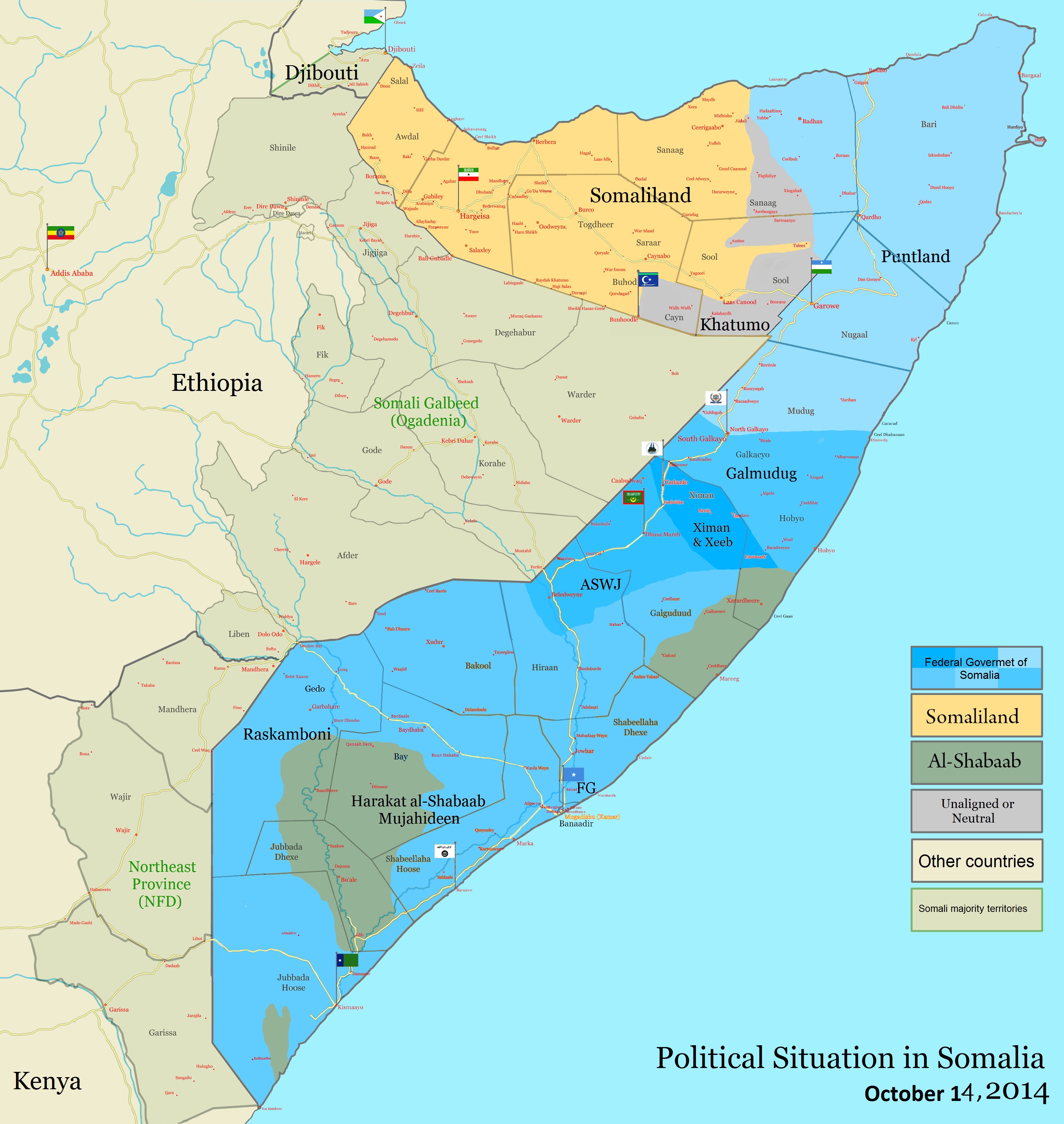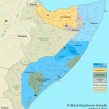
Al-Shabaab: On the Back Foot but Still Dangerous
Publication: Terrorism Monitor Volume: 13 Issue: 2
By:

As the Islamic State and Boko Haram expanded rapidly throughout 2014, gaining territory and power in the Middle East and West Africa respectively, al-Qaeda’s Somali affiliate al-Shabaab was on the back foot, retreating from its strongholds as a result of two major offensives carried out jointly by the Somali National Army (SNA) and African Union Mission in Somalia (AMISOM) troops. Key to this was the integration of over 4,000 Ethiopian troops into AMISOM ranks in January 2014, bolstering the number of African Union troops, who were initially from Uganda, Burundi, Djibouti and Kenya, to 22,126 (Garowe Online, January 22, 2014). Within a month of the Ethiopian reinforcements arriving, SNA and AMISOM launched their largest major joint offensive, dubbed “Operation Eagle,” since they had pushed al-Shabaab out of Mogadishu, the capital, in August 2011 (BBC, January 22, 2014; Daily Nation [Kenya], December 1, 2014).
Al-Shabaab Knocked Back
The joint offensives, whose ultimate goal was to oust al-Shabaab militants from their strongholds in urban areas and to bring more territory under the control of the Somali federal government, began in eight regions in south and central Somalia. In the initial weeks, Ethiopian and SNA troops were assigned to secure major towns in the three regions of Bay, Bakool and Gedo, leading to their capture of four significant towns: Rabdhure, Hudur and Wajid in Bakol and Burdhubo in Gedo (Sabahi Online, March 10, 2014). These towns, and in particular Hudur, which is about 260 miles southwest of Mogadishu and about 55 miles from the Ethiopia border, had previously changed hands between the militants and the Somali government and its allies frequently over the past six years. In addition, these towns had served at different times as training centers for both al-Shabaab and its predecessor al-Itihad al-Islamiya (AIAI, the Islamic Union) (Sabahi Online, March 23, 2012). AIAI had set up its first training camp, known as al-Huda, in Hudur in the 1990s (Waagacusub, October 1, 2013). Following the demise of AIAI, al-Shabaab, which was founded by members of AIAI’s youth wing, established further training camps for its fighters in the area of the Somalia-Ethiopia border. However, in the face of the 2014 offensives, the group chose not to defend these towns, with the exception of Burdhubo, the second largest town in Gedo which the group had controlled the past six years, and instead retreated as the joint Somali-AMISOM forces advanced (VOA Somali, March 9, 2014). As a result, by March 2014, al-Shabaab, which was once one of the most powerful al-Qaeda franchises in the world, had lost six main towns in Bay, Bakool and Gedo regions as well as the associated territory and resources (Hiiraan Online, March 9, 2014).
Meanwhile, in the regions bordering Kenya, the Kenya Defense Forces, operating under AMISOM command from July 2012, made a slow advance into some villages in the Lower Juba region, although they failed to capture the area’s largest towns, and also carried out airstrikes against al-Shabaab leaders and associated foreign fighters on the outskirts of the southern town of Jilib – a district still under the control of al-Shabaab – twice in May alone (Keydmedia, February 6, 2014; Bloomberg, May 20, 2014). But it was the joint contingent from Uganda, Burundi, Djibouti and Ethiopia that made the most significant advances against al-Shabaab in the Lower and Middle Shabelle regions (under Ugandan and Burundian leadership) during this period, as well as in the Hiiraan and Galgadud regions (under Djiboutian and Ethiopian command) (Sabahi Online, October 30, 2014). As the operation went into its third month in March, the joint forces moved deep into al-Shabaab’s strongholds in Lower Shabelle, seizing several key towns and villages including Qoryooley, an important location southwest of Mogadishu that connects coastal and inland areas and is located just 45 miles from the coastal town of Barawe, which was al-Shabaab’s major stronghold at that time (VOA Somali, March 22, 2014).
In the Hiiraan region, Djiboutian and SNA troops enjoyed similar success. By March 2014, they were in control of almost all of the districts and towns of the region including Bulobarde, which had been al-Shabaab’s largest base in the area (BBC Somali, March 13, 2014). Meanwhile, in the central region of Galgadud, Ethiopian and SNA troops took control of the strategic town of Elbur, about 230 miles north of Mogadishu (Kismaayo Online, March 24, 2014). Following this, the rainy season that began in April slowed operations against al-Shabaab, which were then further delayed for month of Ramadan in July (Radio Muqdisho, March 26, 2014).
Following the end of Ramadan, a second joint offensive, dubbed “Operation Indian Ocean,” was launched in late August to end al-Shabaab’s control of coastal towns (Radio Muqdisho, August 30, 2014). These towns were some of al-Shabaab’s main sources of revenue, raised through port operations and taxes on goods. Accordingly, the group’s key port town of Barawe was captured on October 5, 2014; this town had been the group’s single most important commercial asset since its loss of Kismayo in September 2012 (Garowe Online, October 5, 2014). Barawe was particularly vital to al-Shabaab finances as it served as the main hub for a multi-million dollar charcoal trade, which bankrolled a large part of the group’s operations. The group also lost Tiyeeglow district, an important logistical hub for al-Shabaab, located approximately 300 miles northwest of Mogadishu in the Bakool region (Hiiraan Online, August, 26, 2014). According to AMISOM, the town also acted as the biggest transit point for al-Shabaab fighters moving between the north and south of the country (Radio Mustaqbal [Mogadishu], August 25, 2014).
Al-Shabaab Strikes Back
However, even if al-Shabaab was being driven back in conventional fighting across much of the country and also increasingly cut off from its financial assets, the group’s notorious and highly organized intelligence unit, Amniyat, managed to pull off several breathtaking attacks, showing that the movement still had teeth and ambition. Most notably, the unit carried out deadly and high profile strikes on targets in Mogadishu including the Villa Somalia (the presidential compound, twice), the Parliament building, the National Intelligence headquarters and AMISOM’s largest military compound at Halane (Horseedmedia [Bosaso], July 8, 2014; Kulmiye Radio [Mogadishu], May 24, 2014; Hiiraan Online, August 31, 2014; Raxanreeb, December 25, 2014). The attacks underlined that Amniyat is arguably the most effective of al-Shabaab’s units; the unit has a particular responsibility for spying, conducting infiltrations against enemy target – especially federal government and AMISOM installations – as well as carrying out targeted assassinations and suicide attacks against government officials, AMISOM forces and their facilities.
In addition, al-Shabaab has conducted significant high-profile strikes against targets outside Somalia, particularly focusing on countries contributing troops to AMISOM. On May 24, 2014, al-Shabaab carried out a suicide attack on Le Chaumière restaurant in Djibouti that killed a Turkish national and injured several Western soldiers (Midnimo, May 24, 2014). In Kenya, it carried out a massacre in a quarry near the border town of Mandera on December 2, killing 36 Kenyan workers (Garowe Online, December 2, 2014). This followed an earlier attack in Kenya, on November 22, against a bus that left 28 people dead on the Mandera-Nairobi road (Hiiraan Online, November 22, 2014). These attacks show that while al-Shabaab has weakened militarily in Somalia as a conventional force and now controls far less territory than at its height in 2008-2011, the group is still capable of inflicting large-scale casualties, especially against soft civilian targets, including against targets abroad, in a large part thanks to the efficiency of its Amniyat branch.
Conclusion: Al-Shabaab at the Crossroads
At present, as a result of the successful 2014 offensives against it, al-Shabaab does not control a single district in the four regions of Bakool, Hiiraan, Lower and Middle Shabelle in southern Somalia. In Gedo region on the Somalia-Ethiopia-Kenya border, the group controls only Bardere, the largest and most populated district. In total, therefore, the group is now fully in charge of only eight districts and towns: Diinsoor and Ufurow in Bay; Jamaame and Kamsuma in Lower Juba; Bu’ale, Sakow and Jilib in Middle Juba; Eldher in Galgadud and Harardhere in Mudug. Of these, only Harardhere has much commercial value, serving as a port town, which allows the group to profit from the charcoal trade. [2] In a further blow, al-Shabaab’s experienced leader Ahmad Abdi Godane (a.k.a. Mukhtar Abu Zubayr), was killed in a U.S. airstrike in September and the head of Amniyat, Abdishakur Tahlil, was killed in a similar attack in December (Daily Nation, September 4, 2014; al-Jazeera, December 30, 2014). In addition, al-Shabaab’s previous leader of Amniyat, Zakariye Ismail Hersi, was detained by Somali forces on December 27 (VOA Somali, December 27, 2014). In short, al-Shabaab, which in 2009, controlled about half of the country, including the capital, is a shadow of itself, with its key leaders dead or detained, its territorial control crumbling and its finances under attack. At the same time, however, it is risky to predict the ultimate demise of the group, which has previously suffered serious reverses before recovering; for instance, when the U.S.-backed Ethiopian invasion overran the group’s predecessor, the Islamic Courts Union, in 2007.
Indeed, in recent months, the group has shown signs of innovating and of adapting to its new more limited powers. For instance, in most of the districts that the group has lost control of, including Hudur and Buulo Berde in Bakool and Hiiraan regions, its fighters have effectively imposed a blockade, disrupting the supply of food and non-food items, leaving dozens dead from starvation and so far defeating attempts by government and AMISOM troops to secure the roads (Radio Ergo [Nairobi], July 10, 2014). Likewise, although the group has isolated itself from its traditional support base because its harsh punishment of anyone who disagrees with it and its assassinations of Islamic scholars, doctors, academics and students, it continues to control the minds and hearts of significant numbers of fighters and supporters within the Somali public. This will help to drive continued recruitment, while the group has also sought to create new sources of income, for instance, by imposing exorbitant informal “taxes” – effectively protection money – on telecommunications, money transfer companies, big businesses and also transport vehicles that operate on the roads that it controls. Much however, will depend on the actions and character of the group’s new leader, Ahmad Omar (a.k.a. Abu Ubaidah). If Ahmed Omar turns out to be a Somali version of Abu Bakr al-Baghdadi, the man who helped al-Qaeda in Iraq rebrand and rise from the ashes and to then conquer much of Iraq and Syria, then al-Shabaab too may yet rise again. And that could mark the beginning of a new and very long war.
Muhyadin Ahmed Roble is an analyst of African Affairs for The Jamestown Foundation who specialises in conflict, security and counter-terrorism.
Notes
1. AIAI, a pan-Somali organization that sought to establish an Islamic state in Somalia, was founded in the late 1980s, but had disappeared as a military force by 2000.
2. For all of the above, see AMISOM’s Joint Security Operation Update released on October 29, 2014, https://amisom-au.org/2014/10/joint-security-update-on-operation-indian-ocean-by-somali-government-and-amisom/.





